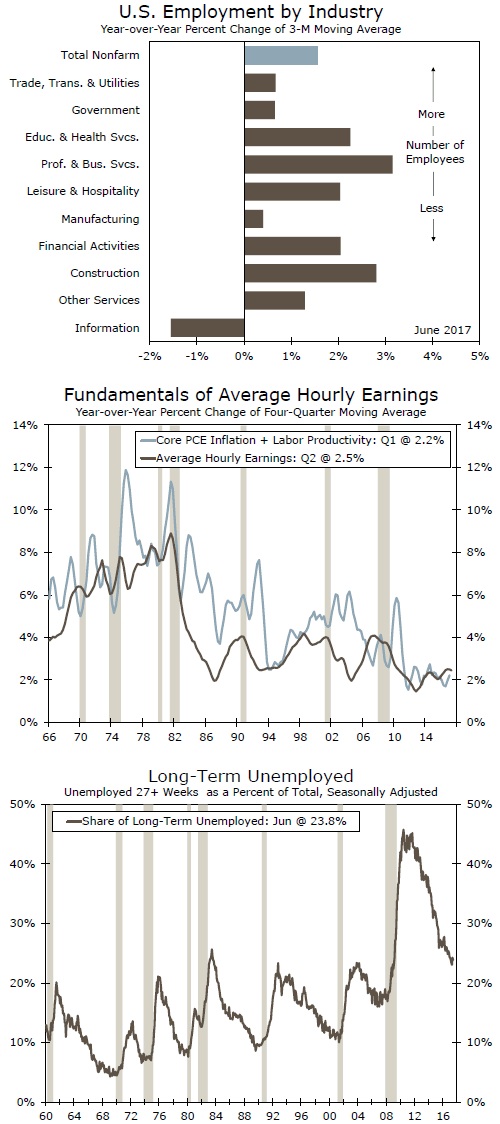June job gains of 222,000 and a rise in wages indicate continued economic growth ahead and a basis for the Fed to continue its current policy path. Beyond the cycle, structural unemployment issues remain.
Jobs Up 222,000 in June: Consistent with Economic Growth
Nonfarm payrolls rose a strong 222,000 in June, with the three month average at 194,000 jobs. Monthly average job gains this year continue the moderating trend started in 2014 and are consistent with a tighter labor market and rising wages/salaries.
Hiring in the services sector remained solid, with gains in business services, education & health, finance and leisure & hospitality (top graph). The local government sector showed a strong gain in June – summer schools?
In the goods sector, manufacturing employment posted a small gain, while hiring in construction was up a solid 16,000 jobs, likely reflecting some seasonal improvement. Our outlook remains for a rebound in real GDP growth in Q2 and gains of roughly 2.5 percent to 3.0 percent for the second half of this year.
Wages: Not an Isolated Number but Part of the Economic System
Job gains, on average, continue to outpace the growth in the labor force, thereby putting downward pressure on the unemployment rate and modest upward pressure on wages.
Average hourly earnings rose 0.2 percent in June, putting the year-ago pace of wage growth at 2.5 percent. Despite continued steady job growth in 2017, earnings have yet to break out of this mid-two percent pace. The softer inflation readings and weak productivity numbers have limited the gains in nominal wage growth. On balance, average hourly and weekly earnings continue to improve and, along with more jobs, support the case for household income gains.
Over the longer run, wages reflect the economic fundamentals of the labor market, and those fundamentals include productivity and inflation (middle chart). During the current cycle, analysts have repeatedly commented on low productivity, while inflation has been persistently below the FOMC’s target of two percent. With both productivity growth and inflation continuing to prove sluggish, it is not altogether surprising that wage growth has disappointed given the performance of the fundamentals.
Structural Problems Persist: Limits Growth
Long-term unemployment (bottom graph) remains higher than levels of the past 30 plus years, signaling a structural shift in the labor market. Recent articles on the opioid epidemic and the shift in behavior of young men towards playing videos games at home rather than work suggest a more structural problem of worker displacement than can be dealt with by monetary policy alone. The net result is a continued lower than expected labor force participation rate, slower than expected economic growth and a gradual rise in wages as employers chase increasingly rare skilled workers.













